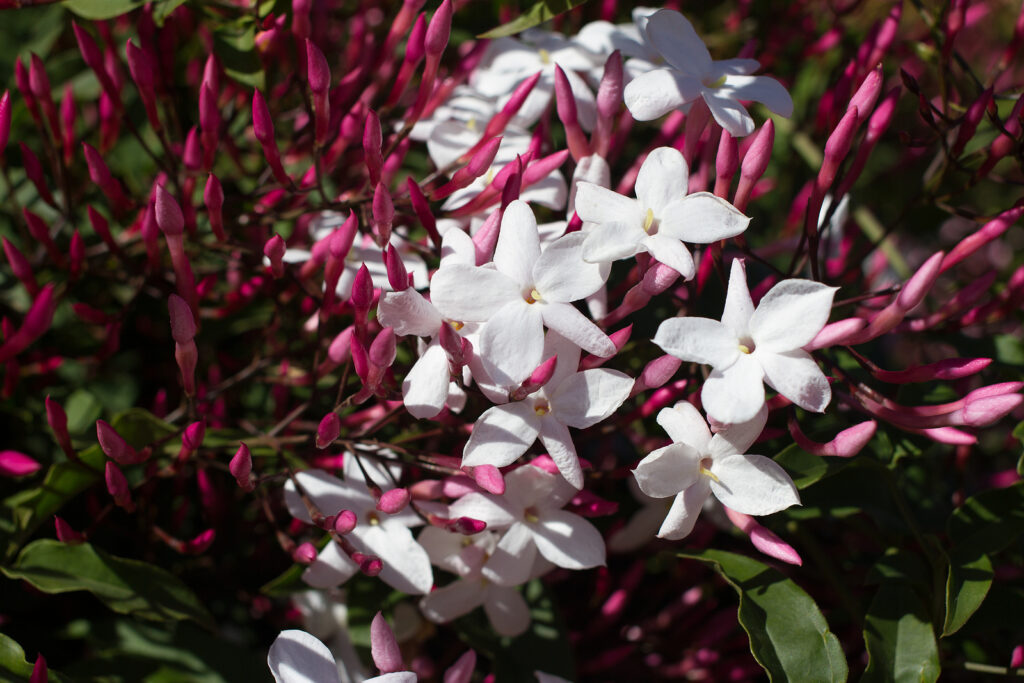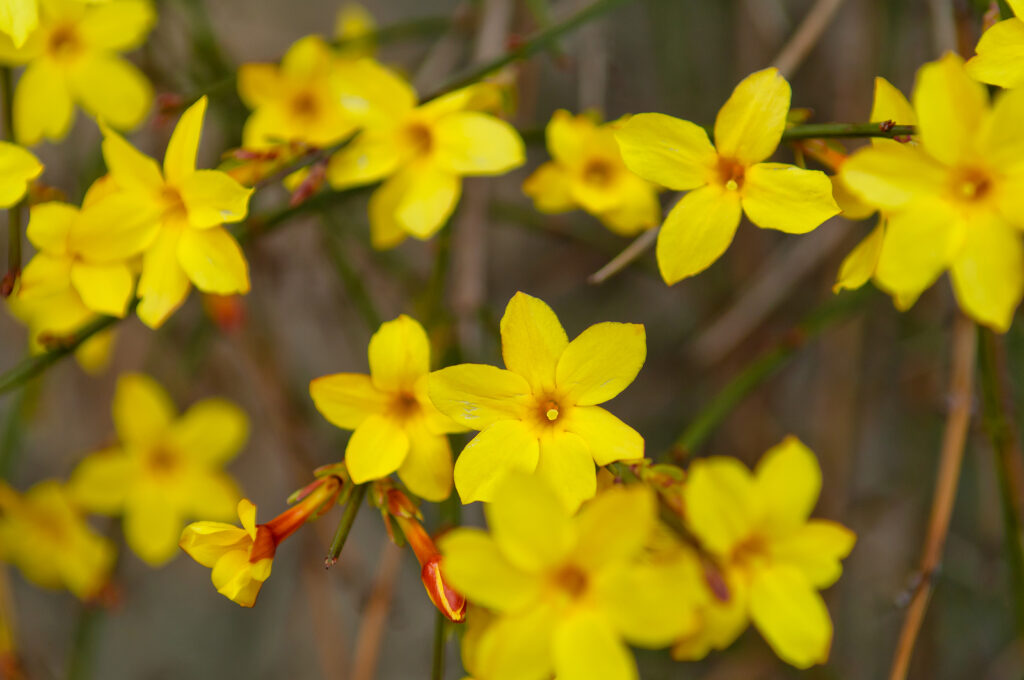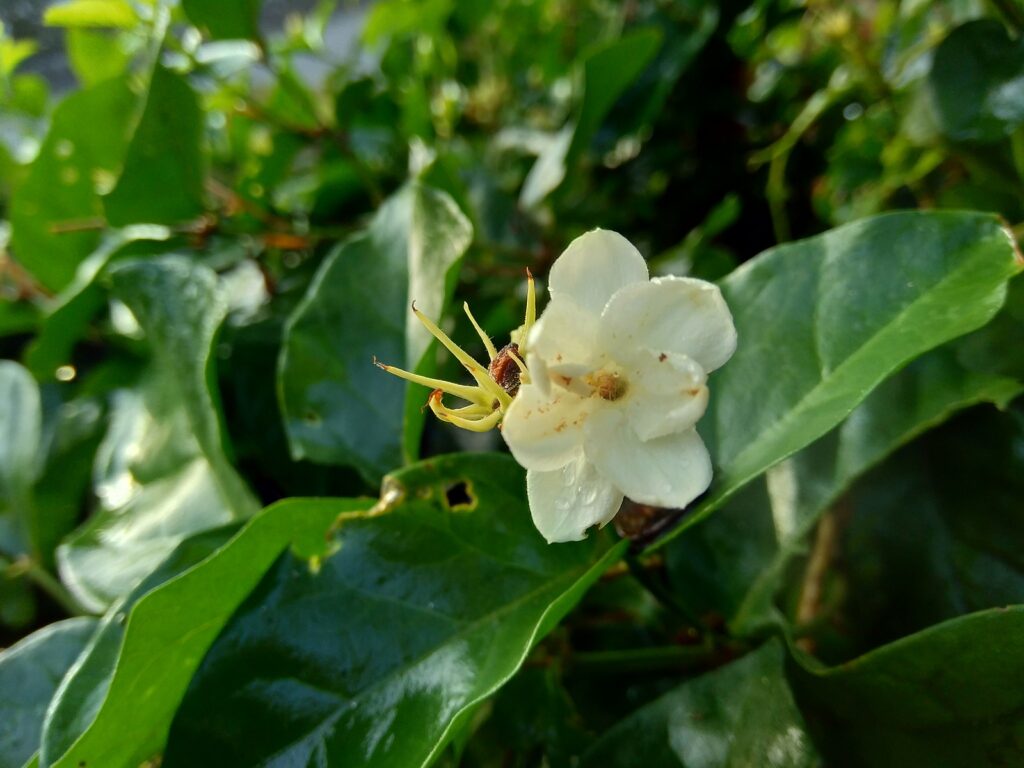Jasmine–botanical name Jasminum–is a vining tropical plant that is primarily grown for its clusters of tubular, star-shaped flowers that are often sweetly fragrant. Jasminum commonly has rich, deep green lance-shaped leaflets often with shoots that will twine around supports.
Some Jasminum species will grow to 20 feet (6m) in tropical regions. Some species are mounding and shrub-like. Jasminum can be trained against support or can be allowed to trail across the ground. Jasminum can be grown on a trellis, fence, or arch. They can be allowed to run down a slope or over a wall.
Jasminum grows best in fertile, well-drained soil in full sun or partial shade. Jasminum should be protected from cool or constant breezes.
Jasminum is a genus of about 200 species of evergreen and semi-evergreen climbers and shrubs. Jasminum is native to woodland and scrubs in tropical and temperate regions of Europe, Asia, and Africa.
Get to know Jasmine — Jasminum
- Plant type: Evergreen and deciduous vines and shrubs
- Growing zones and range: Zones 6 to 9, and in sheltered spots in Zone 5
- Hardiness: Half-hardy; a minimum winter temperature of 45°F is optimal.
- Height and width: 15 feet (4.6m) tall in warm regions if not pruned; in cooler climates from 3 to 8 feet (1-2.4m) in height; 5 to 10 feet (1.5-3m) wide
- Foliage: Long arching stems with shiny dark green leaves that are composed of three slender 1-inch (2.5cm) leaflets; young branches remain green throughout winter
- Flowers: Star-shaped 1-inch (2.5cm) white and sometimes yellow flowers
- Bloom time: Early spring, and even winter in the South
- Uses: Mixed borders
- Common name: Star jasmine, confederate jasmine
- Botanical name: Jasminum
- Family name: Oleaceae
- Origin: Europe, Asia, and Africa

Where to plant Jasminum
- Plant Jasminum in full sun or partial shade.
- Plant Jasminum in fertile, well-drained soil.
When to plant Jasminum
- Plant container-grown Jasminum in spring or autumn.
Planting and spacing Jasminum
- Space Jasminum 5 to 10 feet (1.5-3m) apart.
- Jasminum is sometimes tied to a trellis or wall in the manner of a climbing rose, but they are most frequently grown as a shrub.
How to water and feed Jasminum
- Give Jasminum regular water.
- Feed Jasminum with an all-purpose organic fertilizer in spring.
How to care for Jasminum
- Jasminum branches can be cut and easily forced into bloom indoors in midwinter.
- Since all Jasminum flowers form on the previous season’s growth, not on the current growth, all pruning should be done immediately after flowering.
- Jasminum plants can be pruned severely after flowering without greatly reducing the number of flowers the following season.

Growing Jasminum as a houseplant
- Jasminum grandiflorum, J. nitidum, J. officinale, and J. polyanthum can be grown as houseplants.
- Jasminum prefers average temperature indoors, direct light, and average to high humidity.
- Grow in a well-drained, soilless medium and keep the medium evenly moist during spring and summer. In fall and winter, allow the medium to dry slightly between waterings.
- Fertilize monthly during spring and summer
- After the plant has bloomed prune it back to 6 inches high.
- Provides plants with a trellis, wire hoop, or other support.
- Plants benefit from being placed outdoors in summer.
Jasminum pests and diseases
- Aphids, scale insects, and mealybugs can attack Jasminum.
- Root rot, fungal and bacterial leaf spots, and viruses can occur.
Jasminum propagation
- Propagate Jasminum from softwood cuttings of young growth in late spring or early summer, from semi-hardwood cuttings or more mature growth in mid- or late summer, or from hardwood cuttings of dormant leafless growth in fall or winter.
- Jasminum can also be propagated by forcing a branch to grow roots by ground layering.

Jasminum varieties to grow
- Jasminum angulare, South African jasmine. Evergreen vine grows 10 to 20 feet tall; leaves divided into three leaflets; bears unscented white flowers in groups of three in summer; flowers slightly more than 1 inch (2.5cm) wide.
- J. floridum, showy jasmine. Evergreen to semievergreen grows to 5 feet (1.5m); lustrous dark green leaves have three to five leaflets, and the yellow five-lobed flowers bloom in cymes from mid- to late spring. Zones 8 to 10.
- J. grandiflorum (J. officinale grandiflorum), Spanish jasmine. Semievergreen or deciduous vine; grows rapidly from 10 to 15 feet (3.1-4.6m); glossy green leaves with five to seven leaflets, each is 2 inches (5.1cm) long; fragrant white flowers, 1.5 inches (3.8cm) across, in loose clusters; blooms all summer; gives open, airy effect along fence tops or rails.
- J. humile, Italian yellow jasmine. Evergreen is similar to J. floridum but more upright; grows to about 6 feet (1.8m), and has less glossy leaves; blooms later with slightly fragrant flowers. ‘Revolutum’ may be more cold hardy. Zones 8 to 10.
- J. mesnyi, primrose jasmine. Evergreen mound to 8 feet (2.4m) high and half as wide, with trailing branches and double flowers in early spring; dark green leaves with three lance-shaped, 2-3 inches (5.1-7.6cm) leaflets; square stems; bright yellow, unscented flowers to 2 inches (5.1cm) across are semidouble or double, produced singly rather than in clusters; can be clipped as 3 foot (.9m) high hedge; good for training against a wall.
- J. multiflorum, downy jasmine. Evergreen vines are often trained as shrubs; stems and leaves have a downy coating, producing an overall gray-green effect; often called star jasmine in Florida. The main bloom season comes in late winter or early spring.
- J. multipartitum, African jasmine, and evergreen shrub. Sprawling growth to 2-3 feet (.6-.9m) tall, 10 feet (3.1m) wide. Pink buds at the branch end open into fragrant white summer flowers divided into 8-12 narrow segments.
- J. nitidum, Shining jasmine, Angelwing jasmine. Evergreen to semi-evergreen vines; requires long, warm growing season to bloom satisfactorily; not hardy below 25°F/-4°C; moderate growth from 10 to 20 feet (3.1-6.1m); leathery, uncut, glossy medium green leaves to 2 inches (5.1cm) long; fragrant flowers shaped like 1 inch (2.5cm) pinwheels open from purplish buds in late spring and summer; flowers are white above, purplish beneath, borne in clusters of three. Often sold as J. magnificum.
- J. nudiflorum, Winter jasmine. Deciduous arching or climbing shrub, 4 feet (1.2m) high and 6 feet (1.8m) wide if grown in a border or down a bank, up to 10-12 feet (3.1-3.7m) high if trained against a wall; bright yellow axillary flowers are 2 inches (5.1cm) tubes with spreading lobes 1 inch (2.5cm) across, appearing for a long period in late winter before the foliage. Zones 6 to 9.
- J. officinale, Common white jasmine, Poet’s jasmine. Semievergreen to deciduous twining vine resembles J. grandiflorum; grows to 30 feet (9.1m); fragrant white flowers to 1 inch (2.5cm) across; blooms all summer and into fall; rich green leaves have five to nine leaflets, each up to 2.5 inches (6.4cm) long.
- J. polyanthum, winter jasmine. Grows to 10 feet (3m); has seven leathery, lance-shaped, 3-inch leaflets per leaf; flower buds are pink, and open white, fragrant 3/4 inch, star-shaped flowers in winter and spring; can be kept to 3 to 5 feet tall indoors by pruning.
- J. sambac, Arabian jasmine. Evergreen, twining climber or scrambler; grows 6 to 10 feet (2-3m); lustrous, dark green leaves; some in whorls; leaflets to 3 inches long; bears cymes of start-shaped, scented white flowers that fade to pink.
Jasmine frequently asked questions
Q: Can Jasmine be grown as a house plant?
A: There are several jasmines that can be grown as house plants. White jasmine (Jasminim officinale), pink jasmine (J. polyanthum), and primrose jasmine (J. primulinum) are all climbers which bear white, pink, or yellow flowers in clusters.
Q: How can I be successful in growing Jasmine as a house plant?
A: Indoors jasmine wants average warmth with a minimum winter temperature of 45°F. Keep the plant in bright light with some direct sun. Keep the planting medium moist at all times and mist the leaves frequently. Provide some form of support for the stems. Repot as necessary in spring.
Q: Which jasmine has yellow flowers?
A: Primrose Jasmine (J. primulinum) has yellow flowers. It is the one climbing jasmine whose stems do not twine. The stems must be tied to a support with twine or horticultural tape or allowed to run. Primrose jasmine is not fragrant like most other jasmine.
Q: Can you describe pink jasmine?
A: Pink Jasmine (J. polyanthum) has pink buds which open into tubular flowers in spring. It is a vigorous climber and can grow to 10 feet if left unchecked. Annual pruning is necessary to stop the plant from becoming too straggly.
Q: How is white jasmine different from pink jasmine other than the color of the buds?
A: White jasmine (J. offcinale) is similar to pink jasmine–it has twining stems, much-divided leaves, and long-tubed white flowers with a strong fragrance. It differs from pink jasmine in several important ways–the flowers appear from summer to early autumn and they do not have a rosy tinge on the reverse. Also, the blooms do not appear until the plant is mature.















